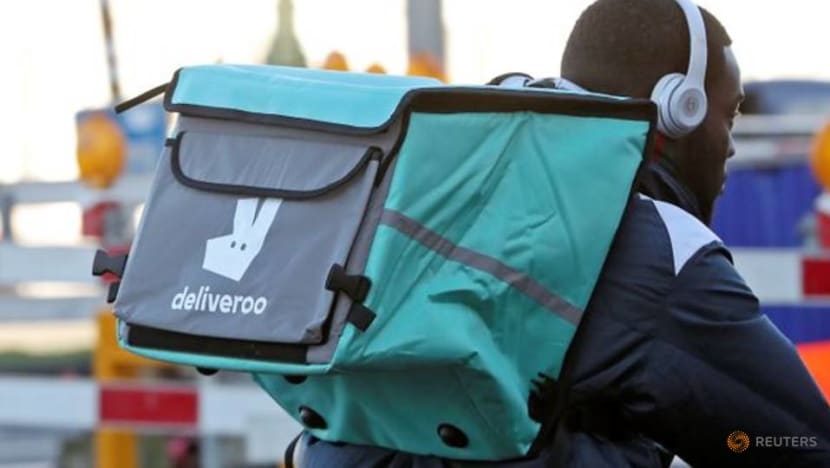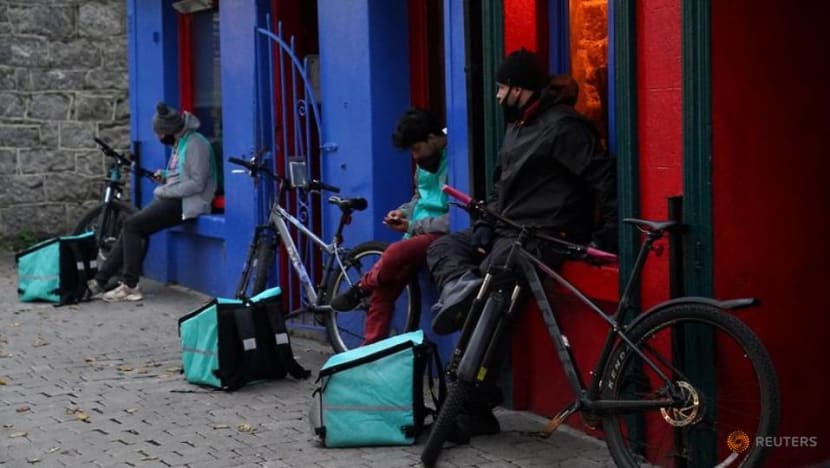commentary Commentary
Commentary: Deliveroo’s IPO - like changing tires while driving
Deliveroo seemed to have defied fundamentals in 2020, which is good news ahead of its London stock market listing, but its prospects do not look good, says IMD Business School’s Howard Yu.

A courier for food delivery service Deliveroo rides a bike in central Brussels, Belgium on Jan 16, 2020. (Photo: REUTERS/ Yves Herman)
LAUSANNE: There are two rules for a good business. You want to be in a growing market, and you want to have the ability to differentiate yourself.
In the tech sector, you want to do both on a global scale. No company reaches a billion-dollar valuation if it’s merely a local play.
So when Deliveroo said it would be listed on London Stock Exchange, investors began assessing its growth momentum. The UK-founded food delivery company was backed by Amazon, and that’s a vote of confidence.
It’s expected to reach a potential valuation of US$7 billion, a huge bump from the pre-COVID-19 estimate of US$2 billion to US$5 billion.
READ: Commentary: The gig economy – a surprise boost from the pandemic and in Singapore, it’s not going anywhere
But the question is not how well it does during the COVID-19 crisis. The more important question investors hoping to snatch its shares should ask themselves, can Deliveroo thrive after the pandemic?
AN UNLIKELY RESCUE BY A TECH GIANT
COVID-19 has been a major accelerant of business trends. E-commerce took off after people starting shop at home. Similarly, because people had to stop visiting banks, they learnt how to manage their finances online.
What does a family’s stuck at home do? They order food delivery. According to Morgan Stanley, the US digital food delivery market will grow to US$467 billion in the next five years. And yet, this growth has not yet translated to profitability for Deliveroo.
Deliveroo just posted a loss of US$309 million for 2020 despite a 54 per cent revenue growth.

Its results for 2019 were worse, with revenues at 62 per cent higher at around US$1 billion. But losses also rose to US$440 million after significant investment.
In retrospect, the pandemic was a mixed bag for the food delivery giant. The lockdown of restaurants and pubs in the UK almost bankrupted the company. Business volume dried up. Global layoffs were announced. That’s when Amazon stepped in to lead a US$575 million funding round in April.
It turns out the hyper-growth experienced by DoorDash, Grubhub, and Postmates in the US didn’t quite translate over to Europe. It all depended on the degree of social restrictions.
The soaring popularity of food delivery didn’t protect its financial fragility.
READ: Commentary: Multibillion-dollar wizards – how COVID-19 is exposing what’s behind the curtain
READ: Commentary: Don’t be too quick to write off the sharing economy, even with COVID-19
GREAT FOR CONUSMERS, BAD FOR THE BOTTOM LINE
Delivery platforms like Deliveroo or Uber Eats typically charge a 15 per cent to 30 per cent commission on each order. But restaurants are subsisting on razor-thin margins (often less than 50 per cent).
Even without COVID-19, 80 per cent of New York restaurants close in the first five years. It’s a tough industry driven by the passion of heroic entrepreneurs rather than money.
Yes, meal delivery had been a band-aid for restaurants during the pandemic. The shift in consumer behaviours over the long run, however, will cannibalise on-premise sales. And this is bad.
The New York Times reported that two pizzerias that previously generated profits between US$50,000 and US$100,000 started to lose as much as $40,000 annually once customers shifted to delivery.
There are many reasons for this. The orders for each delivery are often cheaper. Most people don’t order fancy cocktails or champagne together with takeout. People buy booze at stores.
Since customers don’t see the servers, their tips are less generous. Then there are the additional expenses for drivers and bikers. There’s no single cause for the bad economics. It’s death by a thousand cuts.
One year since the pandemic, why do users, riders and restaurants alike still have complaints about food delivery apps? A business professor and a ride-hailing app founder weigh in on CNA's Heart of the Matter podcast:
EVERYONE COMPETES THE SAME WAY
Meanwhile, delivery platforms are seen as interchangeable. You can’t tell the real difference when ordering from different platforms. Most troubling is that the “network effect” hardly materialises.
The importance of network effects for online platforms is well known. Whether you are Facebook, Google, Twitter, or Amazon, being big makes you bigger.
You want to have the most restaurants signed up for your platform so that most diners will use your platform when looking for food. The problem is that no one knows how to do this except by throwing discounts and incentives to motivate people to sign up.
That leads to ruinous competition. These delivery platforms become big spenders on paid ads on Google and Facebook. They call it market investment, but they are merely buying temporary market shares.
READ: Commentary: Maybe private-hire drivers and food delivery riders don’t want full-time jobs
To be clear, there will never be any network effect at the global level for Deliveroo or Uber Eats or DoorDash. Consumers in London would care only about the number of restaurants in the city. And those restaurant listings have no allure for consumers in Hong Kong.
Contrast this with Airbnb. A New Yorker cares a lot about the number of Airbnb hosts in other cities that they plan to visit.
That means Airbnb’s network has had global appeal from day one. A copycat competitor would have to enter the market on a global scale. That’s a much harder thing to do.
READ: Commentary: What is the logic of AirAsia entering Singapore’s food delivery market?
The bottom line is Deliveroo will always have a lot of competition, unlike Airbnb, which can enjoy its monopolistic position.
THE NEED TO PIVOT QUICKLY
No business can thrive when its business model is damaging the ecosystem that it operates within. That’s why Deliveroo is moving away from relying solely on one business.
It is now tapping into new areas, such as online grocery deliveries. It’s setting up a series of partnerships with supermarket chains, including Sainsbury’s, Aldi, and Carrefour.
It is launching a business catering service. It’s even pioneering “ghost kitchens,” which are cooking facilities that produce food only for delivery or takeout.

If anything, Deliveroo is trying to deemphasise its reliance on its core business if delivering food from restaurants.
Of course, reinvention is nothing new. Companies have to reinvent themselves constantly. What makes this case special is that the upstart needs to reinvent itself at the same time it is close to getting publicly listed.
IPOs are usually means to raise financial capital for a proven business model so it can scale up further. Yet, for Deliveroo, it means raising capital for the company to pivot in a whole new direction.
In other words, it’s changing tires while driving on two wheels. Others in the food delivery business looking to list, like Grab, should sit up.
SIGN UP: For CNA’s Commentary weekly newsletter to explore issues beyond the headlines
Howard Yu is LEGO Professor of Management and Innovation at IMD Business School as well as the director for the Center for Future Readiness.















